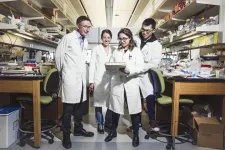(Press-News.org) BOSTON - In the first study to use whole genome sequencing (WGS) to discover rare genomic variants associated with Alzheimer's disease (AD), researchers have identified 13 such variants (or mutations). In another novel finding, this study establishes new genetic links between AD and the function of synapses, which are the junctions that transmit information between neurons, and neuroplasticity, or the ability of neurons to reorganize the brain's neural network. These discoveries could help guide development of new therapies for this devastating neurological condition. Researchers at Massachusetts General Hospital (MGH), the Harvard T. H. Chan School of Public Health, and Beth Israel Deaconess Medical Center report these findings in Alzheimer's & Dementia: The Journal of the Alzheimer's Association.
Over the last four decades, MGH has pioneered research on the genetic origins of AD, led by Rudolph Tanzi, PhD, vice chair of Neurology and director of the hospital's Genetics and Aging Research Unit. Notably, Tanzi and colleagues co-discovered genes that cause early onset (prior to age 60) familial AD (that is, a form that runs in families), including the amyloid protein (A4) precursor (APP), and the presenilin genes (PSEN1 and PSEN2). Mutations in these genes lead to accumulation of amyloid plaques in the brain, a hallmark of AD.
The next 30 AD gene variants that were discovered are primarily linked to chronic inflammation in the brain (or neuroinflammation), which also increases the risk for this cognitive disease. However, loss of synapses is the neurological change that is most closely correlated with the severity of dementia in Alzheimer's disease, yet no clear genetic links between the disease and these vital connections had previously been identified. "It was always kind of surprising that whole-genome screens had not identified Alzheimer's genes that are directly involved with synapses and neuroplasticity," says Tanzi.
Prior to this paper, the genome-wide association study (GWAS) was the primary tool used for identifying AD genes. In a GWAS, the genomes of many individuals are scanned in search of common gene variants that occur more frequently in people who have a given disease, such as AD. But to date, common Alzheimer's-associated gene variants have accounted for less than half of the heritability of AD. A standard GWAS misses the rare gene variants (those occurring in less than 1% of the population), a problem solved by the WGS, which scans every bit of DNA in a genome.
"This paper brings us to the next stage of disease-gene discovery by allowing us to look at the entire sequence of the human genome and assess the rare genomic variants, which we couldn't do before," says Dmitry Prokopenko, PhD, of MGH's McCance Center for Brain Health, who is lead author of the study.
Identifying less-common gene mutations that increase the risk for AD is important because they may hold critical information about the biology of the disease, says Tanzi. "Rare gene variants are the dark matter of the human genome," he says, and there are lots of them: Of the three billion pairs of nucleotide bases that form a complete set of DNA, each person has 50 to 60 million gene variants--and 77% are rare.
In their quest to find rare AD gene variants, Tanzi, Prokopenko and their colleagues performed WGS analyses on the genomes of 2,247 individuals from 605 families that include multiple members who have been diagnosed with AD. They also analyzed WGS datasets on 1,669 unrelated individuals. The study identified 13 previously unknown rare gene variants associated with AD. Strikingly, these gene variants were associated with functioning of synapses, development of neurons, and neuroplasticity.
"With this study, we believe we have created a new template for going beyond standard GWAS and association of disease with common genome variants, in which you miss much of the genetic landscape of the disease," says Tanzi, who sees potential for their methods to be used to study the genetics of many other conditions. Moreover, he plans to use "Alzheimer's in a dish"--three-dimensional cell culture models and brain organoids he and his colleagues have developed over the past decade--to explore what happens when the rare mutations this paper identified are inserted in neurons. "That could help guide us in novel drug discovery," says Tanzi.
INFORMATION:
Tanzi is the Joseph P. and Rose F. Kennedy Professor of Neurology at Harvard Medical School (HMS) and co-director of the McCance Center for Brain Health at MGH. Prokopenko is an instructor in Neurology at HMS.
This study was supported by the Cure Alzheimer's Fund and grants from the National Institutes of Health.
About the Massachusetts General Hospital
Massachusetts General Hospital, founded in 1811, is the original and largest teaching hospital of Harvard Medical School. END
Bottom Line: Among patients at high risk of melanoma, those who received routine skin cancer screening and education about skin self-exams were significantly more likely to be diagnosed with thinner and earlier stage melanomas.
Journal in Which the Study was Published: Cancer Epidemiology, Biomarkers & Prevention, a journal of the American Association for Cancer Research
Author: Michael Sargen, MD, a dermatologist and clinical fellow in the Division of Cancer Epidemiology and Genetics at the National Cancer Institute (NCI), part of the National Institutes of Health (NIH)
Background: "Whole-body screening for melanoma is currently routine for individuals at high ...
The Tibet ASγ experiment, a China-Japan joint research project on cosmic-ray observation, has discovered ultra-high-energy diffuse gamma rays from the Milky Way galaxy. The highest energy detected is estimated to be unprecedentedly high, nearly 1 Peta electronvolts (PeV, or one million billion eV).
Surprisingly, these gamma rays do not point back to known high-energy gamma-ray sources, but are spread out across the Milky Way (see Fig.1).
Scientists believe these gamma rays are produced by the nuclear interaction between cosmic rays escaping from the most powerful galactic sources ...
A dangerous toxin has been witnessed - for the first time - releasing into the air from pond scum, research published in the peer-reviewed journal Lake and Reservoir Management today shows.
Not only is pond scum - otherwise known as algal bloom - an unsightly formation which can occur on still water across the world, it can also prove dangerous to wildlife and humans.
For the first time, scientists have now detected the presence of the algal toxin anatoxin-a (ATX)which is also known as 'Very Fast Death Factor', in the air near a Massachusetts pond with large algal blooms.
ATX can cause a range of symptoms at acute doses, including loss of coordination, muscular twitching and respiratory paralysis, and has been linked to the deaths of livestock, waterfowl and dogs from ...
Researchers from University of Queensland, University of Melbourne, and Universidad Finis Terrae published a new paper in the Journal of Marketing that studies consumer resistance to a nationwide plastic bag ban implemented in Chile in 2019.
The study, forthcoming in the Journal of Marketing, is titled "How Do I Carry All This Now?': Understanding Consumer Resistance to Sustainability Interventions" and is authored by Claudia Gonzalez-Arcos, Alison M. Joubert, Daiane Scaraboto, and Jörgen Sandberg.
As environmental crisis challenges accelerate, governments are searching for solutions to reduce the negative impacts of economic activity. One popular measure has been to ban disposable plastic ...
A palliative care doctor has suggested that studying Shakespeare's plays could help medical students connect more closely with their patients. Writing in the Journal of the Royal Society of Medicine Dr David Jeffrey, of the Department of Palliative Medicine at the University of Edinburgh, investigates how the playwright's empathic approach - the ability to understand and share the feelings of another - can enhance the patient-doctor relationship.
Dr Jeffrey writes that the idea that emotions are disruptive and need to be controlled is deeply ingrained in medical education and practice, contributing to doctors distancing from patients. The coronavirus pandemic, with ...
Fewer than half of inmates in jails and prisons surveyed in a study by the CDC and University of Washington said they would accept a COVID-19 vaccine, while the majority either said they wanted to wait before getting the vaccine or would refuse one.
"This is a population already at risk for COVID-19, and outbreaks among incarcerated people can worsen inequities in COVID-19 outcomes as well as contribute to spread in the surrounding community," said lead author Dr. Marc Stern, affiliate assistant professor of health services in the UW School of Public Health. "So culturally and health-literacy informed interventions are needed to help them feel more confident about getting vaccinated."
The study conducted by CDC researchers ...
As the COVID-19 pandemic lingers, researchers have found associations between certain lifestyle factors and a person's risk of getting infected. While it has already been established that those with Type II diabetes and a high body mass index (BMI) are at greater risk of experiencing hospitalizations and other severe complications related to COVID-19, they are also at greater risk of getting symptomatic infection in the first place. That is the finding of a recent study conducted by researchers at the University of Maryland School of Medicine that was published today in the journal PLoS ONE.
Using data from the UK Biobank of 500,000 British volunteers over age 40, the researchers examined ...
ROCHESTER, Minn. -- All too often, patients with high levels of antibodies face major challenges getting a transplant. These highly sensitized patients have a much higher risk of death while waiting for suitable organs they are less likely to reject. But there is new hope for highly sensitized patients in need of a combined heart and liver transplant, thanks to an innovative surgical approach at Mayo Clinic.
Traditionally, surgeons transplant the heart first, followed by the liver. But Mayo Clinic heart transplant team decided to reverse the order for highly sensitized patients in the hopes that the liver would absorb some of the patient's antibodies, removing them from circulation and lowering ...
Researchers have confirmed for the first time that Pine Island Glacier in West Antarctica could cross tipping points, leading to a rapid and irreversible retreat which would have significant consequences for global sea level.
Pine Island Glacier is a region of fast-flowing ice draining an area of West Antarctica approximately two thirds the size of the UK. The glacier is a particular cause for concern as it is losing more ice than any other glacier in Antarctica.
Currently, Pine Island Glacier together with its neighbouring Thwaites glacier are responsible for about 10% of the ongoing increase in global sea level.
Scientists have argued for some time that this region of Antarctica could reach a tipping point and undergo an irreversible ...
Kidney development is a balancing act between the self-renewal of stem and progenitor cells to maintain and expand their numbers, and the differentiation of these cells into more specialized cell types. In a new study in the journal eLife from Andy McMahon's laboratory in the Department of Stem Cell Biology and Regenerative Medicine at the Keck School of Medicine of USC, former graduate student Alex Quiyu Guo and a team of scientists demonstrate the importance of a molecule called β-catenin in striking this balance.
β-catenin is a key driver at the end of a complex signaling cascade known as the Wnt pathway. Wnt signaling plays critical roles in the embryonic development of multiple organs including the kidneys. By partnering with ...


